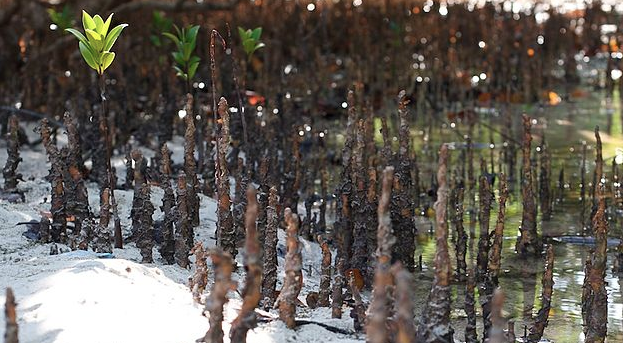Orlando Sentinel
January, 2016 Naples, FL
[dropcap]W[/dropcap]enliang Wang has never seen the leafless dead mangroves that poke into the sky over a flooded mud flat between Goodland and Marco Island.
But the Chinese billionaire wants to restore them anyway.
Rookery Bay National Estuarine Research Reserve is counting on as much as $5 million from Wang’s international conglomerate Rilin Industrial Group to restore the 225-acre black mangrove forest along San Marco Road and then apply the same fix to die-offs around the world.
Wang’s advisers, who visited the site last week, say it’s just what he does: “He has no motive other than the environment,” said Ted Venners, chairman of China Green, a Las Vegas-based company that brought the Rookery Bay project to Wang.
For project manager Robin Lewis, Wang’s involvement means the restoration is getting money that it has been lacking for years.
“It was like a blessing from heaven to have someone interested in our project,” said Lewis, president of Coastal Resources Group.
The die-off about a mile west of Goodland has been decades in the making, scientists say. The construction of San Marco Road, also known as State Road 92, in 1938 cut off tidal flow that feeds the mangroves from Fruit Farm Creek. Mangroves depend on that flow to survive — Lewis calls it their heartbeat. When Hurricane Andrew came through in 1992, rains flooded the forest. By 1995, the die-off was apparent.
“Water can get in but it can’t get out,” Lewis said. “Left alone this problem just gets worse and worse and worse.”
Lewis’ solution is simple. He plans to install new culverts under San Marco Road and, where needed, dig barely perceptible channels to help water get into the forest. Instead of water standing for months, drowning the mangroves, water will flow in and out.



![By Dennis Tang (https://www.flickr.com/photos/tangysd/4251167812/) [CC BY-SA 2.0 (http://creativecommons.org/licenses/by-sa/2.0)], via Wikimedia Commons](https://flylifemagazine.com/wp-content/uploads/2016/01/Screen-Shot-2016-01-21-at-7.35.10-AM-300x165.png)